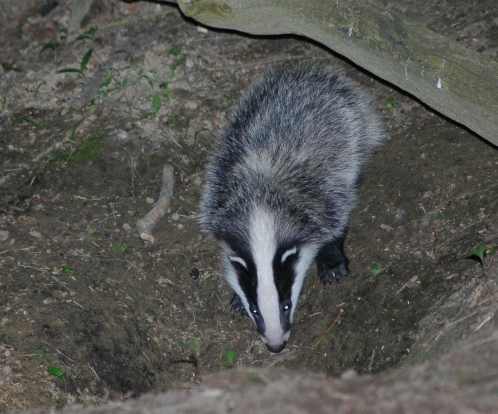News
One of the most controversial wildlife issues in the UK today is the role of badgers in the transmission of bovine tuberculosis (bTB). A cross-disciplinary Oxford research team (led by David Macdonald and Adrian Smith) have identified badger-specific features of the immune response that may underpin badger susceptibility to bTB. Some of the results of this study also identify avenues that may be useful to boost the response to vacating badgers.
Attempts to control the spread of bovine tuberculosis (bTB) in cattle cost the UK taxpayer c. £99 m/annum (2013–14), yet the problem continues to worsen. The benefits of culling badgers have been disputed and hope has turned to vaccinating them (Bacillus Calmette–Guérin (BCG) has been promising when injected at tenfold the dose used on people). Indeed, WildCRU had been participating in DEFRA’s Badger Edge Vaccination Scheme (BEVs) until last year a fire at the lab producing the vaccine interrupted European supply. Meanwhile, WildCRU doctoral student Kirstin Bilham and postdoctoral scientist Amy Boyd led a collaboration to better understand how the badgers’ immune system responds to bTB challenge – understanding aimed at enhancing vaccine development and deployment strategies, work just published in Nature Scientific Reports.
To look at the realities of vaccination, we had been working with DEFRA as part of their Badger Edge Vaccination Scheme (BEVs) until sadly last year a fire at the lab producing vaccine interrupted European supply. It is hoped, however, that this scheme will resume in 2018, and so it is crucial to better understand how the badgers’ immune system responds to bTB challenge, in order to enhance vaccine development and deployment strategies. Despite difficulties with vaccine supply, we have nevertheless undertaken a critical study of badger innate immunity, just published in Nature – Scientific Reports. This is inter-disciplinary work transcending ecology and immunology, and involves some complex cellular physiology; but, ‘in a nutshell’, let us explain what we have found.
Taking blood samples to the lab, the team tested the ability of badger macrophages (a type of white blood cell) to respond to pathogen exposure. Macrophages are the main cell type infected by the bTB bacterium and key cells involved in combatting a range of infections. We found that these cells responded to most stimuli by upregulating an array of inflammatory mediators. Unexpectedly, however, badger macrophages failed to produce nitric oxide, which is known to be a key anti-TB molecule in other species. Badger macrophages also expressed low levels of a receptor involved in sensing bacterial DNA (called Toll-like receptor 9). Both of these features may contribute to the innate susceptibility of badgers to bTB and support the wider use of vaccination to equip badgers with a capacity to resist infection with bTB.
That’s the nub of it, but for those wanting a bit more explanation; TB is caused by a microbe called mycobacteria and bovine tuberculosis (bTB) is caused by Mycobacterium bovis. These TB bacteria actively invade and replicate in macrophages. The macrophage is not simply a vessel for growth of TB it actively fights the infection, but to do so macrophages must first identify the pathogen and then make molecules that can kill the bacterium. The TLR receptors on the cellular membranes of macrophages are able to recognise specific groups of pathogens, initiating anti-pathogen immune responses. In mammals, there are around 10 TLRs and each has a different specificity, recognising different pathogen associated molecules. Two are particularly important in recognition of bTB, TLR2 and TLR9. Badger macrophages respond well through the TLR2 pathway but express very low levels of TLR9 compromising recognition of bTB. Triggering the TLR typically results in activation of many responses, including pro-inflammatory cytokines (cytokines communicate and activate surrounding cells) and pathogen killing mechanisms such as nitric oxide production. Although important in immune defence and in cell signalling nitric oxide and other free radicals can be dangerous (loosely equivalent, in a military metaphor, to friendly fire) – that is why mammals have evolved ‘antioxidants’ so much beloved of trendy diets. Anyone on heart medication, such as nitro-glycerine or amyl nitrate, benefits from the vaso-dilating qualities of nitric oxide. So, when macrophages are stimulated via TLRs or interferon gamma the inducible nitric oxide synthase (iNOS) response should kick in and produce nitric oxide, which then kills pathogens like TB. The importance of this process is highlighted by the fact that lab mice deficient in iNOS are highly susceptible to TB.
We found that in lab tests badger macrophages fail to produce nitric oxide or upregulate iNOS following activation via TLR and/or interferon gamma pathways. Despite the lack of nitric oxide, most TLR stimuli induced appropriately increased levels of cytokines, indicating that TLR recognition pathways were intact. As outlined above, the only exception was the low TLR9 responses, as a result of the very low expression of this TLR. Macrophages co-ordinate many other immune cells and, in badgers, most pathways are intact but the lack of NO and reduced TLR9 signalling may result in increased susceptibility of badgers to bTB.
As to why badgers might have evolved this immunological deficiency, symptoms of ‘disease’ generally arise from the severity of the body’s own immune reactions (termed ‘immunopathology’) – and so if the pathogen can be tolerated, there can be advantages in not becoming sick. This idea may also explain why badgers can carry TB for years, without becoming morbid and infectious. Our hope is that our findings will be a step towards the development of more targeted vaccines to stimulate alternative badger immune pathways to enable badgers to mount a more effective immune response to bTB.






